The Intel 6th Gen Skylake Review: Core i7-6700K and i5-6600K Tested
by Ian Cutress on August 5, 2015 8:00 AM ESTDDR4 vs DDR3L on Gaming
For this set of tests, we kept things simple for the results – a low end single R7 240 DDR3, an ex-high end GTX 770 Lightning and a top line GTX 980 on our standard CPU game set under normal conditions. However it is the integrated results that should throw up the biggest difference.
Alien: Isolation
If first person survival mixed with horror is your sort of thing, then Alien: Isolation, based off of the Alien franchise, should be an interesting title. Developed by The Creative Assembly and released in October 2014, Alien: Isolation has won numerous awards from Game Of The Year to several top 10s/25s and Best Horror titles, ratcheting up over a million sales by February 2015. Alien: Isolation uses a custom built engine which includes dynamic sound effects and should be fully multi-core enabled.
For low end graphics, we test at 720p with Ultra settings, whereas for mid and high range graphics we bump this up to 1080p, taking the average frame rate as our marker with a scripted version of the built-in benchmark.
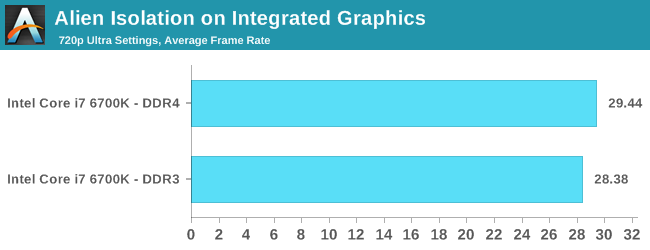
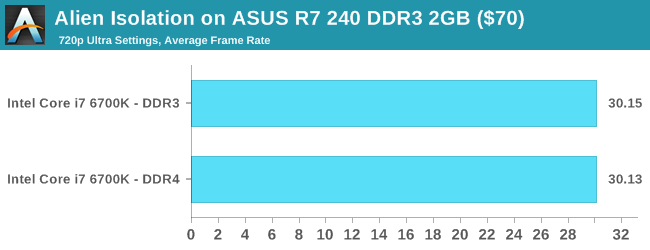
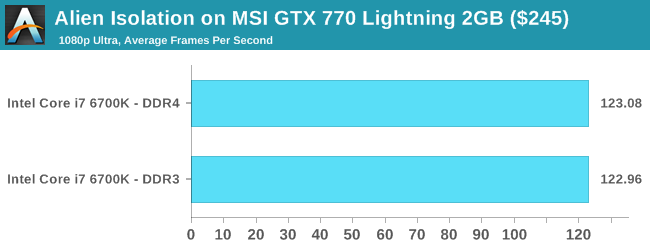
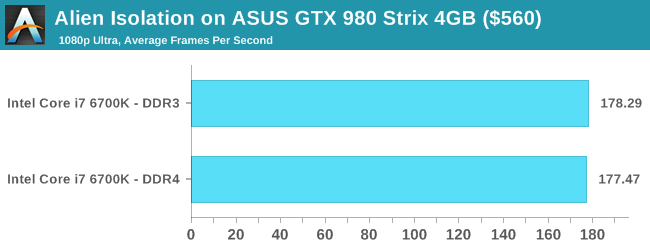
Total War: Attila
The Total War franchise moves on to Attila, another The Creative Assembly development, and is a stand-alone strategy title set in 395AD where the main story line lets the gamer take control of the leader of the Huns in order to conquer parts of the world. Graphically the game can render hundreds/thousands of units on screen at once, all with their individual actions and can put some of the big cards to task.
For low end graphics, we test at 720p with performance settings, recording the average frame rate. With mid and high range graphics, we test at 1080p with the quality setting. In both circumstances, unlimited video memory is enabled and the in-game scripted benchmark is used.
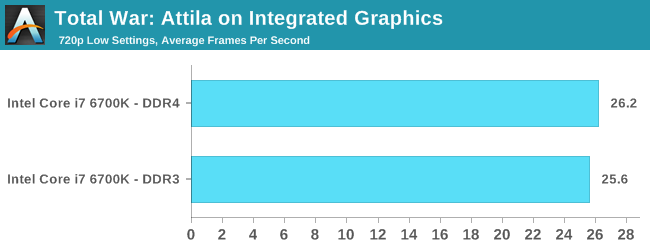
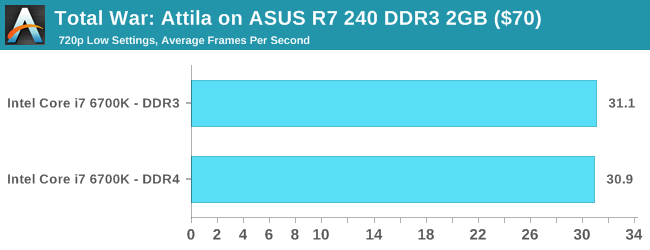
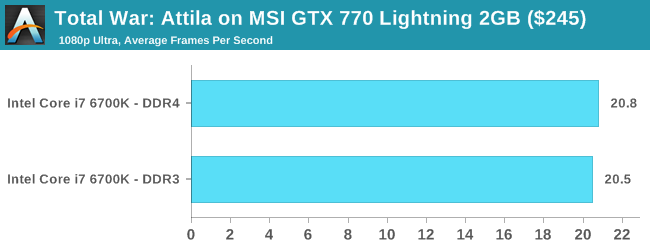
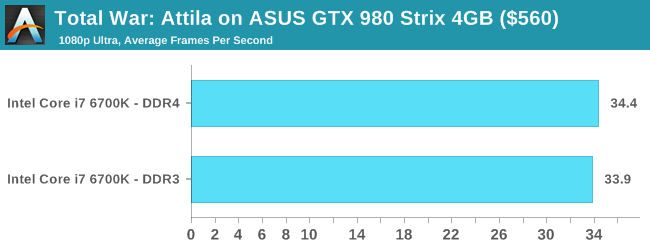
Grand Theft Auto V
The highly anticipated iteration of the Grand Theft Auto franchise finally hit the shelves on April 14th 2015, with both AMD and NVIDIA in tow to help optimize the title. GTA doesn’t provide graphical presets, but opens up the options to users and extends the boundaries by pushing even the hardest systems to the limit using Rockstar’s Advanced Game Engine. Whether the user is flying high in the mountains with long draw distances or dealing with assorted trash in the city, when cranked up to maximum it creates stunning visuals but hard work for both the CPU and the GPU.
For our test we have scripted a version of the in-game benchmark, relying only on the final part which combines a flight scene along with an in-city drive-by followed by a tanker explosion. For low end systems we test at 720p on the lowest settings, whereas mid and high end graphics play at 1080p with very high settings across the board. We record both the average frame rate and the percentage of frames under 60 FPS (16.6ms).
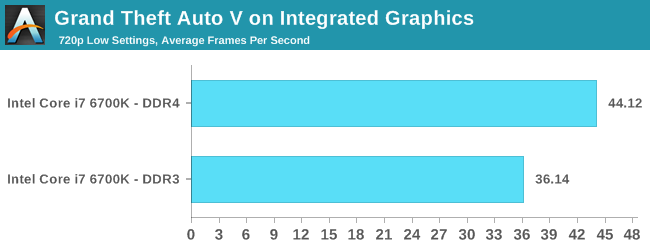
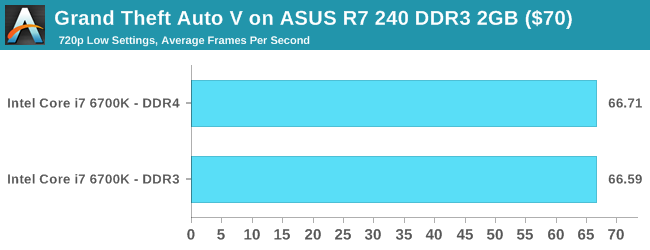
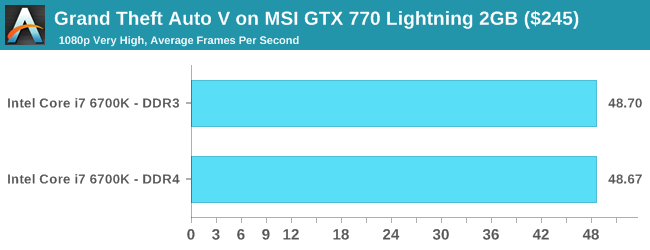

GRID: Autosport
No graphics tests are complete without some input from Codemasters and the EGO engine, which means for this round of testing we point towards GRID: Autosport, the next iteration in the GRID and racing genre. As with our previous racing testing, each update to the engine aims to add in effects, reflections, detail and realism, with Codemasters making ‘authenticity’ a main focal point for this version.
GRID’s benchmark mode is very flexible, and as a result we created a test race using a shortened version of the Red Bull Ring with twelve cars doing two laps. The car is focus starts last and is quite fast, but usually finishes second or third. For low end graphics we test at 1080p medium settings, whereas mid and high end graphics get the full 1080p maximum. Both the average and minimum frame rates are recorded.
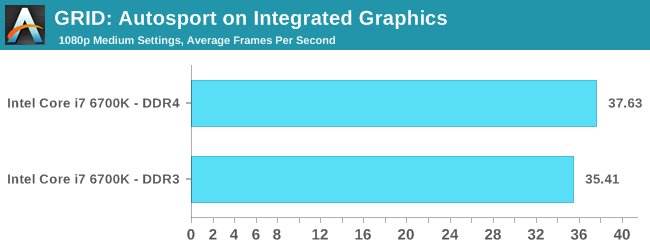
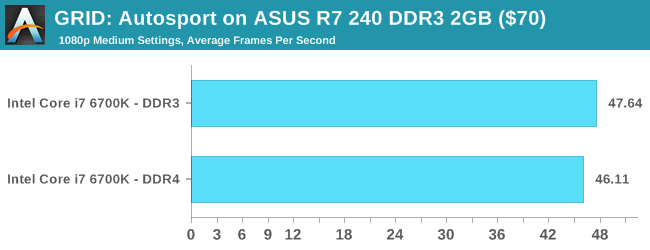
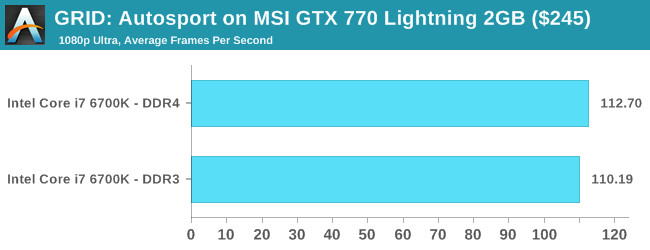
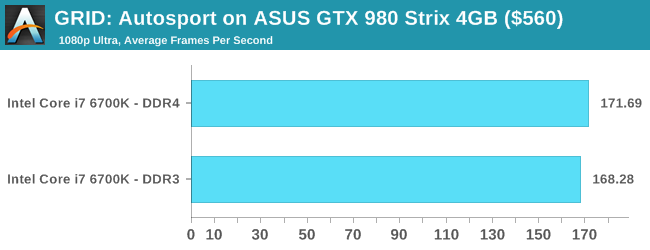
Middle-Earth: Shadow of Mordor
The final title in our testing is another battle of system performance with the open world action-adventure title, Shadow of Mordor. Produced by Monolith using the LithTech Jupiter EX engine and numerous detail add-ons, SoM goes for detail and complexity to a large extent, despite having to be cut down from the original plans. The main story itself was written by the same writer as Red Dead Redemption, and it received Zero Punctuation’s Game of The Year in 2014.
For testing purposes, SoM gives a dynamic screen resolution setting, allowing us to render at high resolutions that are then scaled down to the monitor. As a result, we get several tests using the in-game benchmark. For low end graphics we examine at 720p with low settings, whereas mid and high end graphics get 1080p Ultra. The top graphics test is also redone at 3840x2160, also with Ultra settings, and we also test two cards at 4K where possible.
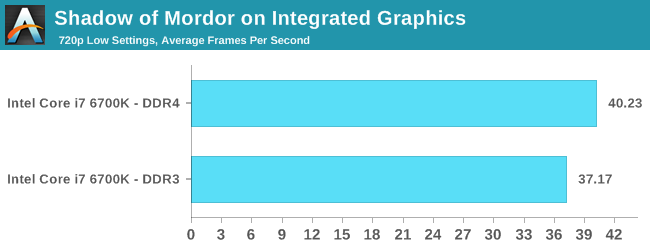
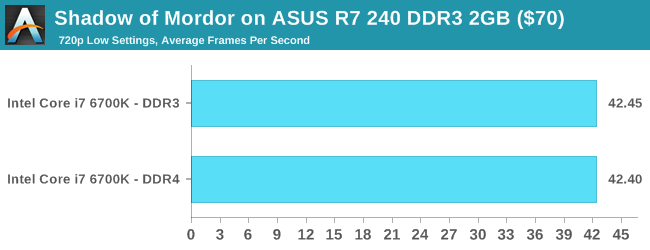
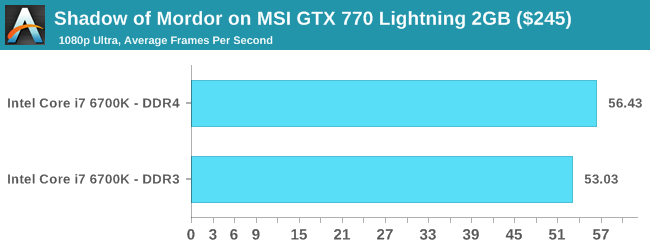
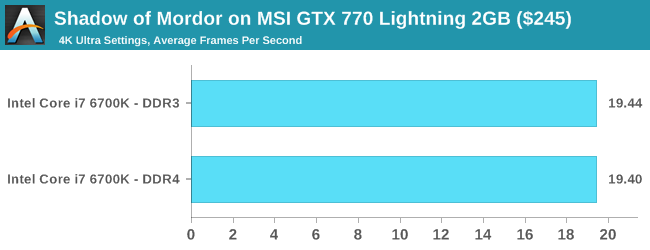
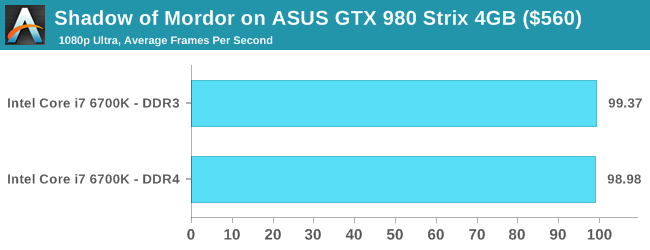
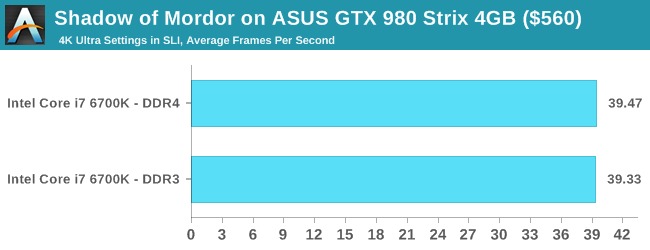
Conclusions on Gaming, DDR3 vs DDR4
Focusing on purely the integrated graphics, DDR4 is the clear winner with an average 7.0% gain in average frame rates. We also took stock of the minimum frame rates too, and they went up 5.8% as well. So for integrated graphics, moving to even the base DDR4 memory kit wins out.
For discrete graphics card testing, only three differences stand out here. For GRID on the R7 240 the DDR4 set loses by 3.2%, but for the GTX 770 the DDR4 wins on Mordor by 6.4% and on GRID by 2.3%. All other differences are below 2%, mostly on the side of DDR4.















477 Comments
View All Comments
taltamir - Friday, October 23, 2015 - link
Recognizing reality as it is, and being willing to admit that AMD is a joke, does not make someone an intel fanboy nor does it mean they want intel to win and AMD to fold.Samus - Wednesday, August 5, 2015 - link
This launch and the performance of skylake over haswell/broadwell is entirely unexpected because it is wholly unnecessary. The ipc improvement is upward of 10% in some cases, when normally it has been 4-6% in the past. It's amazing that the ipc improvement over nehalem is almost 50% while using nearly half the power. They are finally progressing after dogging along since sandybridgeptmmac - Saturday, August 8, 2015 - link
Intel has been turning a double decked supertanker to catch mobile chips on dozens of smaller platforms. Notably Apple is riding on a trialled super yacht and is leading the pack. The real,race going on right now is who will build the first photonics based chip and actually make money selling it. Intel is in that race, but we don't really have much data as to who will take the lead there. The real race is heading towards where the puck will be in 10 years. This is like watching Americas cup in the 50's. It is not important to the average person.Jaybus - Monday, August 10, 2015 - link
Expect hybrid chips first. These will have photonic i/o with electronic cores. This will allow an inter-chip [serial] bus at core-clock speeds, drastically reducing the need for on-chip caching and replacing 64 (or more) traces from CPU to DRAM with a single optical trace. L3 (maybe L2) could likely be eliminated, freeing up real estate and reducing power. Essentially, it allows using DRAM modules, peripheral chips, and even GPUs and other CPUs as if they were all on-chip. Actual photonic cores would come later, perhaps much later.CaedenV - Wednesday, August 5, 2015 - link
And we would all buy that processor rather than eternally waiting in purgatory. I really hope AMD puts out something amazing, even if I am not going to buy it.TheGladiator2212 - Friday, October 16, 2020 - link
Yup...This comment aged badly
Mariosti - Friday, September 10, 2021 - link
Well, this comment didn't age well.prisonerX - Thursday, August 6, 2015 - link
I think the funniest thing is how people bag AMD and praise Intel while paying through the nose for CPUs that are marginally faster (or marginally slower) than last generation.It's especially funny since Intel is selling its hottest chips (TDP wise, compared to other CPUs it makes) to the "mainstream" while wasting a huge % of the die on a useless integrated GPU that no-one who is willing to pay actually uses.
I always buy AMD because I support competition, it gives me much better value for my money, provides more balanced and batter matched performance and because I'm not a child I have no need for bragging rights about the singe threaded performance of my CPU that I don't need.
D. Lister - Thursday, August 6, 2015 - link
"I always buy AMD because I support competition, it gives me much better value for my money, provides more balanced and batter matched performance and because I'm not a child I have no need for bragging rights about the singe threaded performance of my CPU that I don't need."That's right... children brag about single-thread performance (was there anyone in this section actually doing that though?). Adults, on the other hand apparently, brag about several things simultaneously, like the better performance per dollar of their purchase, and having a superior sense of maturity, morality, economics and technology.
You sir, are duly nominated for the AnandTech comment section's esteemed "Irony of The Month" award for August '15... bravo!
Eugene86 - Thursday, August 6, 2015 - link
Well he's gotta justify that purchase decision to himself somehow...